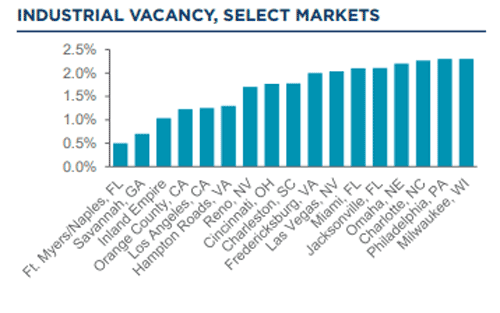Overall the market for industrial space – mostly warehouses - remained robust in 2022, but with signs of weakening as the year ended.
A new report from real estate firm Cushman & Wakefield notes that “absorption’ levels of space remained high in 2022. The US industrial market finished 2022 with its second highest total for overall net absorption on record at 477.3 million square feet (msf), coming in just behind the 561.4 msf registered in 2021.
Supply Chain Digest Says... |
|
|
However, on a quarterly basis, slowing demand amid economic headwinds, coupled with historically tight market conditions, pushed the fourth quarter total to 107.3 msf, which was down 9.4% from the third quarter.
Nevertheless, this marked the ninth straight quarter in which absorption surpassed the 100-msf mark and indicates that demand for warehouse space remains strong going into 2023.
Regionally, the South represented almost half of the square feet absorbed throughout the quarter, despite accounting for just one-third of the nation’s inventory. Of the 81 markets tracked by Cushman & Wakefield, 19 recorded more than 2.0 msf of net absorption in the fourth quarter while another nine exceeded 1.0 msf.
For the third year in a row, the US industrial market inked more than 700 msf of new leasing volume with 757 msf signed throughout 2022. This was the second-best year in history, only behind the 923 msf in 2021. Although ecommerce transactions fell in comparison to 2020 and 2021, other industries propelled demand totals during 2022.
Strong activity by retailers, wholesalers, third party logistics (3PLs) and manufacturing companies drove another healthy quarter of leasing. However, tenant demand began to tick lower in the second half of 2022 as some tenants began to tap the brakes amid the uncertainty around the economy and a deceleration in consumer spending on goods. In the fourth quarter, gross industrial leasing declined by 28% quarter-over-quarter (QoQ) and by 37% year-over-year (YoY).
Vacancy Still Below Pre-pandemic Levels
Amid another quarter of healthy construction deliveries coupled with tempered deal activity, the US industrial vacancy rate ticked to 3.3% - just slightly higher than ht the prior quarter. Despite the uptick, vacancy is still 1.4% lower than it was pre-pandemic and remains more than 3% lower than its 10-year average of 6.5%. (See graphic below).

Source: Cushan & Wakefield
The West (2.6%) and Northeast (3.2%) boasted the lowest vacancy rates with their port-proximate industrial markets including Los Angeles, Savannah, Northern New Jersey, and Charleston which are among the tightest in the nation.
(See More Below)
|
CATEGORY SPONSOR: SOFTEON |
|
|
| |
|
|
12 markets registered vacancy rates of 2.0% or lower at year-end. Meanwhile, vacant sublease space ticked higher, albeit nominally since midyear, with the national sublease vacancy rate ending 2022 at 0.2%.
Rents Show Signs of Moderation
Asking rents for industrial space soared in 2022 but have shown signs of moderating in recent quarters. In the fourth quarter, the average industrial asking rental rate climbed only 1.0% QoQ to $8.81 per square foot (psf) but swelled by 18.6% YoY, marking the strongest year in history for annual rental rate growth. Meanwhile, within warehouse/distribution facilities, the key driver of the industrial market, asking rents surged by 21.6% annually (but only 0.6% QoQ). Just five of the 81 markets tracked yielded double-digit quarterly increases while 24 markets recorded YoY growth rates of 20% or higher.
Charleston, Inland Empire, Phoenix, and Miami all recorded annual gains of 40% or higher. Coastal and port/population-proximate markets continued to be priced at a premium over the rest of the country with nine of the 10 highest priced warehouse markets concentrated within California and New York/New Jersey.
In conclusion, Cushman & Warefield say that “Supply should continue to outpace demand as the development pipeline remains robust with the majority of developments anticipated to deliver in 2023,” adding that “With much of the space being built on a speculative basis, there is a risk of overbuilding in certain markets in the near-term. In the face of an increasingly difficult economic climate and the Fed pursuing additional hike rates, we anticipate construction starts to slow down.”
Do you have any thoughts on the US Warehouse market? Let us know your thoughts at the Feedback button below (email) or in the Feedback section.
|